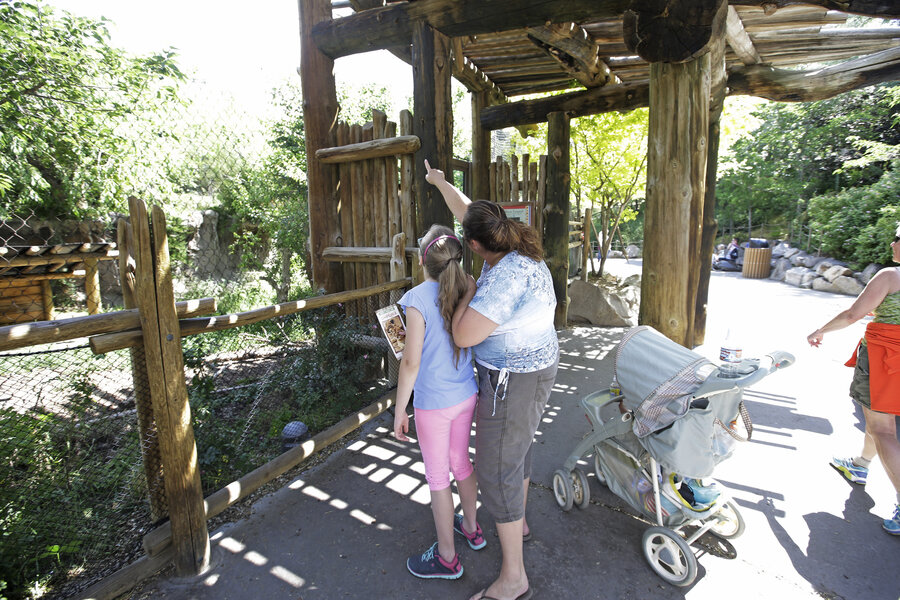Leopard on the loose: How Salt Lake City zoo kept visitors and animals safe
Loading...
Hundreds of Salt Lake City zoo visitors took shelter inside buildings Tuesday morning after a rare leopard escaped and fell asleep on a beam just above where visitors would have gathered to watch her.
A visitor spotted the 4-year-old female snoozing on the outdoor beam about two feet from the exhibit, Hogle Zoospokeswoman Erica Hansen said. She told a zookeeper, who raised the alarm.
An emergency team tranquilized the Amur leopard, packed her into a crate and took her to a holding area.
No one was hurt, and the leopard named Zeya is expected to be fine after the tranquilizer wears off, said Nancy Carpenter, associate director of animal health at the zoo. The animal instinctually hung onto the beam after the tranquilizer dart struck, leaving visible claw marks on the wooden beam.
She eventually fell the final three feet to the ground and landed in a garden area between the visitor fence and her mesh enclosure.
Hansen said they don't yet know how or when the leopard managed to get through the tall steel-grade mesh that surrounds the top and sides of her enclosure, but officials are investigating.
The reports of a wild animal on the loose caused quite a commotion on social media, and even spawned a parody Twitter account. The first tweet by the account, HogleZooLeopard, said "I'm finally free!"
But zoo visitors who were inside said the situation played out calmly and orderly.
Stephanie Gardner said she was looking at the giraffes at the zoo when a staff member told her and her family to take shelter in the gift shop with about 40 other people because of a situation. She said there was "no chaos or anything."
Steve Jones said he and his family were at the monkey exhibit when zoo staff told them to get inside the bistro. They waited inside with several hundred people. Kids were playing, he said.
"We never did feel in danger," Jones, 63, of South Jordan, Utah, said.
The leopard was reported missing at 9:30 a.m. It was captured, and people were allowed out of buildings about an hour later, Hansen said. It's not clear exactly how long she was out, but zoo staff saw her inside the enclosure at about 7 a.m. The animal was spotted outside her enclosure shortly after the zoo opened to the public.
Tuesday also marked the re-opening of Cincinnati zoo's gorilla exhibit after a similar incident ended tragically on May 28. Harambe, a 400-pound male gorilla, was fatally shot to protect a four-year-old boy who ventured into the animal's enclosure. And like Zeya, Harambe represented a critically endangered species.
As The Monitor's Henry Gass wrote last week:
Harambe's death has come amid a climate of heightened public interest in how humans treat animals - both in captivity and in the wild. A shifting understanding in the United States about the needs of individual animals, stoked by documentaries such as "An Apology for Elephants" and "Blackfish," have caused such organizations such as Ringling Bros. and Barnum & Bailey Circus and SeaWorld to back away from showcasing large mammals as entertainment.
The role of zoos is a more complicated topic, however. On the one hand, they keep animals in captivity. On the other, they promote worldwide conservation efforts and work to preserve critically endangered species, like the western lowland gorilla. The question for some ethicists is whether the resources being spent to house and care for animals would be better spent supporting populations in the wild.
There are two Amur leopards at the Salt Lake City zoo. Hansen said the other leopard is in a separate enclosure and did not escape.
The leopard that escaped is a petite, 60-pound animal that has only been at the zoo for a few years. She was brought in from a sanctuary in England to mate with the other Amur leopard, she said.
Amur leopards are considered critically endangered, according to the conservation organization World Wildlife Fund. There are only about 60 of them left in the wild.
Hansen said it is rare for animals to get loose at the zoo. In 2006, the zoo was evacuated when a gray wolf scaled the wall of her pen. The animal was shot with a tranquilizer dart and captured within zoo boundaries after about an hour. No one was hurt in that incident.
In 1999, three chimpanzees at the Salt Lake City Zoo escaped through an unlocked enclosure door and attacked and injured two zoo workers. Zoo employees fired shotguns instead of tranquilizer darts at two of the chimps, which were then euthanized. A third chimp was relocated to a Kansas zoo, and the U.S. Department of Agriculture issued a mild reprimand to the zoo for failing to keep the enclosure secured.
The zoo hasn't had chimpanzees since that incident, Hansen said.
Last month, a zoo in Cincinnati shot and killed a gorilla when a young boy got into its exhibit and was dragged by the 400-pound animal.
While the leopard was quickly contained in Utah on Tuesday, if the animal had actively threatened people zooofficials would have used lethal force, Carpenter said.
The lines outside the Utah zoo grew long during the hour-long shut down, but the zoo has since re-opened. Many people returned to finish their outing after staff gave the all-clear signal.
The U.S. Department of Agriculture last inspected the zoo on May 3 and found no violations.







